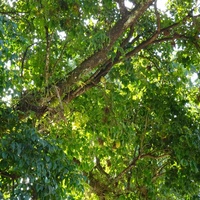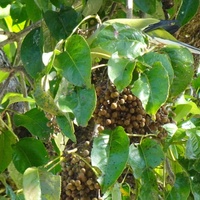Common name: Bishopwood
Other common names: Autumn maple, Java cedar, Needlebark, Toog tree
Description
Bishopwood is a landscape and timber tree originating from a wide geographic area, its natural range extending from India, through Southeast Asia, to Australia and the Pacific.
It is a fast-growing tree up to 30 m (100 ft) tall in native forests. However, it is typically 15 to 20 m (50 to 65 ft) on open sites with a solid trunk and low branches spreading wide, forming a densely leafy, rounded crown. The bark is soft, smooth reddish-brown on young trees, becoming flaking on mature trees.
The leaves are trifoliate, consisting of three dark glossy green oval leaflets up to 13 cm (5 in) long with toothed margins and a thick, leathery texture. They remain on the tree throughout the year in the wetter parts of its range, but in the drier parts with a pronounced dry season, they turn reddish-bronze and fall off the tree.
In spring, small or insignificant, petal-less, greenish flowers bloom in narrow clusters at the ends of the branches, with female and male flowers borne on separate trees. They are followed by small, round, green fruit that ripen in autumn, turning bright red in clusters resembling a bunch of grapes.
Use
It was once widely cultivated as a landscape tree in southern Florida for its shapely form and shade. However, its planting is now strongly discouraged due to its ability to quickly spread to areas outside of cultivation and upset the natural ecology.
Despite its fast growth, it yields a moderately heavy wood, averaging around 540 to 620 kilograms per cubic meter (34 to 39 lbs per cubic ft) with red to dark red-brown heartwood. Reports on its natural resistance to rot and decay are conflicting, ranging from resistant to non-resistant, suggesting high variability in wood quality among individual trees. And it is difficult to dry and prone to splitting. Still, it is reportedly well-suited to underwater construction, such as buried pilings used to build bridges, piers and docks. Small diameter logs and branchwood are converted into charcoal.
A red dye extracted from the bark is used in traditional fabric dyeing in the Pacific region.
Climate
Grows naturally in humid subtropical and tropical lowland to mid-elevation climates, generally areas with annual lows of 16 to 25°C, annual highs of 27 to 35°C, annual rainfall of 1200 to 2500 mm and a dry season of 3 to 7 months.
Growing
New plants are usually grown from seed or cuttings. A good practice is to start new plants from cuttings taken only from male trees, which do not produce fruit and are therefore a low weed risk. It performs well on a wide range of soils, from free-draining to seasonally flooded and from moderately acid to moderately alkaline, generally with a pH of 5.0 to 8.0 and on sites with full to partial sun exposure.
Problem features
Birds are attracted to the fruit and disperse the seed outside of cultivation. The sale of seedling plants is banned in some areas in Florida. Despite being native to Australia, it is classed there as an invasive species, the most serious weed classification used in that country. The Hawaii Pacific Weed Risk Assessment project (HPWRA) assessed it as a high weed risk species for Hawaii.
The branches are brittle and can break off in strong winds, potentially causing personal injury or property damage. The roots are invasive, with the ability to lift or crack paved areas and form surface roots. The ripe fruit fall to the ground creating messy litter and staining paved areas and other surfaces.
Where it grows
References
Books
-
Barwick, M., et al. 2004, Tropical & subtropical trees : a worldwide encyclopaedic guide, Thames and Hudson, London
-
C.A.B. International 2013, The CABI encyclopedia of forest trees, CABI Publishing, Wallingford, Oxfordshire
-
Chaplin, L. T. & Brandies M. M. 1998, The Florida Gardener's Book of Lists, Taylor Publishing Company, Dallas, Texas
-
Dastur, J. F. 1964, Useful plants of India and Pakistan : a popular handbook of trees and plants of industrial, economic, and commercial utility, 2nd ed., D. B. Taraporevala Sons, Bombay
-
Elevitch, C. R & Wilkinson, K. M. 2000, Agroforestry Guides for Pacific Islands, 1st ed., Permanent Agriculture Resources, Holualoa, Hawaii
-
Gilman, E. F. 1997, Trees for urban and suburban landscapes, Delmar Publishers, Albany, New York
-
Jim, C.Y. 1990, Trees in Hong Kong: Species for Landscape Planting, Hong Kong University Press, Hong Kong
-
Kraemer, J. H. 1945, Native woods for construction purposes in the South China Sea region, Bureau of Yards and Docks, United States Navy Department, Washington D.C.
-
Krishen, P. 2006, Trees of Delhi : a field guide, Dorling Kindersley Publishers, Delhi
-
Lemmens R.H.M.J., Louppe, D. & Oteng-Amoako, A.A. (Editors) 2012, Plant Resources of Tropical Africa, Volume 7(2) : Timbers 2, PROTA Foundation, Backhuys Publishers, Leiden
-
Luna, R. K 1996, Plantation trees, International Book Distributors, Dehradun, Uttarakhand
-
Randall, R. P. 2007, The introduced flora of Australia and its weed status, Cooperative Research Centre for Australian Weed Management, Glen Osmond, South Australia
-
Reyes, G. 1992, Wood densities of tropical tree species, U.S. Department of Agriculture, Forest Service, Southern Forest Experiment Station, New Orleans, Louisiana
-
Scheffer, T. C & Morrell, J. J. 1998, Natural durability of wood : a worldwide checklist of species, Forest Research Laboratory, Oregon State University, Corvallis, Oregon
Articles, Journals, Reports and Working Papers
-
Morton, J. F. 1976, Pestiferous spread of many ornamental and fruit species in south Florida. In Proceedings of the Florida State Horticultural Society (Vol. 89, pp. 348-353).
-
Seth, M.K 2003-10-01, 'Trees and their economic importance' The Botanical Review, vol. 69, no. 4, pp. 321(56).



